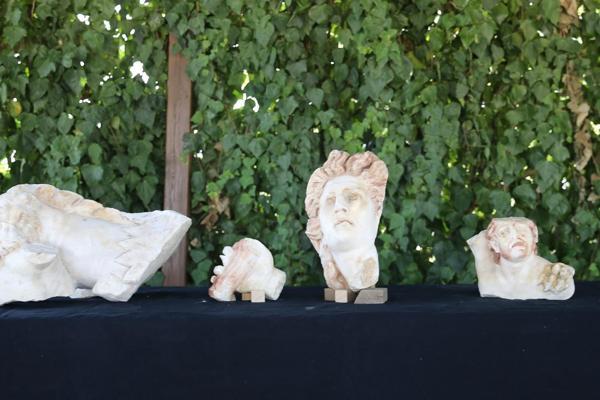'Skylla Group' statues found in Laodicea
DENİZLİ


The colorful Skylla Group statues have come to light during the ongoing excavations in the ancient city of Laodicea in the western province of Denizli.
"These extraordinary statues are very important as they are rare works that reflect the baroque style of the Hellenistic era and have survived to the present day with their original paint," Culture and Tourism Minister Mehmet Nuri Ersoy said in a statement.
Professor Celal Şimşek, the head of the Laodicea excavations, stated that the finding created excitement in the archaeological world. "It is the earliest Hellenistic era copy found in the archaeological world so far."
The ancient city of Laodicea dates back to 5500 B.C. and is home to one of the seven churches mentioned in the Bible. The statue of Asclepius, which is the god of medicine in Greek and Roman mythology, and the head of a statue belonging to his daughter Hygieia were found this year during the excavations carried out in the Western Theater area.
The Skylla Group statues were found during the restoration of the stage building. The statues, which highly excited archaeologists, were removed from their place.
"Our 'Legacy to the Future' application, which is the most comprehensive and ambitious project of Turkish archaeology, gives result. During the restoration work of the stage building, carried out within this project, the unique and colorful Skylla Group statues were discovered. These extraordinary sculptures are very important as they are rare works that reflect the baroque style of the Hellenistic era and have survived to the present day with their original paints,” Şimşek said.
“The restoration of the cavea seating steps in the Laodicea Western Theater, built in the second century B.C. in the Hellenistic era, has been completed in accordance with the project, and we are continuing the restoration work of the stage building with a large expert team within the scope of the 'Laodicea Heritage for the Future Project' in 2024," he said.
“Excavations were carried out in the basement section connected to the hyposcene corridors where the materials were stored under the artists' dressing rooms. Some statues of the three-story stage building of the theater were intact and some were broken due to the end of pagan beliefs and the beginning of Christianity in the 4th century B.C. In Homer's ‘Odyssey,’ among the events that Odysseus goes through on his return to his homeland, his encounter with the sea monster Scylla has an important place. Scylla is a sea monster with a woman's head and wild dogs surrounding the lower part of her body that lurks in the Straits of Messina. As Odysseus' ship passes in front of the cave where this monster is lurking, the dogs attack and eat Odysseus' six friends Stesios, Ormenios, Ankhimos, Ornytos, Sinopos and Amphinomos,” Şimşek said.
He said that the Skylla Group sculptures were made in the Hellenistic era Baroque style by Rhodes sculptors Athanadoros, Hagesandros and Polydoros in the early 2nd century B.C.
Noting that the only copy of the statue group dating back to the early Roman period was discovered in 1957 in front of a cave in Sperlonga, in western Italy, where Emperor Tiberius had his villa, Şimşek said: "However, this group that we found in the Laodicea Western Theater dates back to the late Hellenistic-early empire, that is, the early Augustan Period, between 27 B.C. and 14 A.D., and is the earliest original group of Hellenistic-origin identified in the archaeological world so far. The statue group has a special and unique place in terms of style, aesthetics and artistic quality. In addition, the statue group was found in its original painted form. The baroque artwork on the head of Skylla is unique. The paints on the ship's oar, held by Skylla, and the representation of the fingers in the hand are perfect. The paints of the figure have been preserved very well and have survived to the present day."
